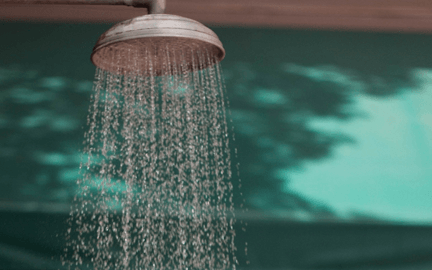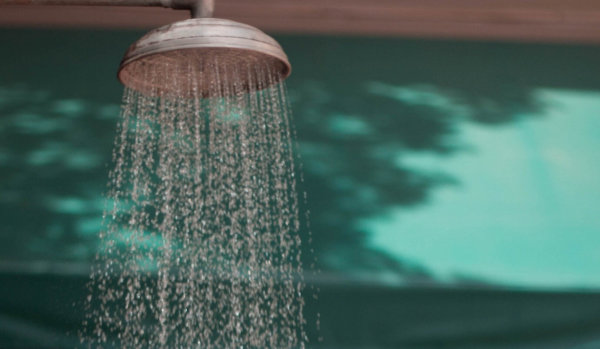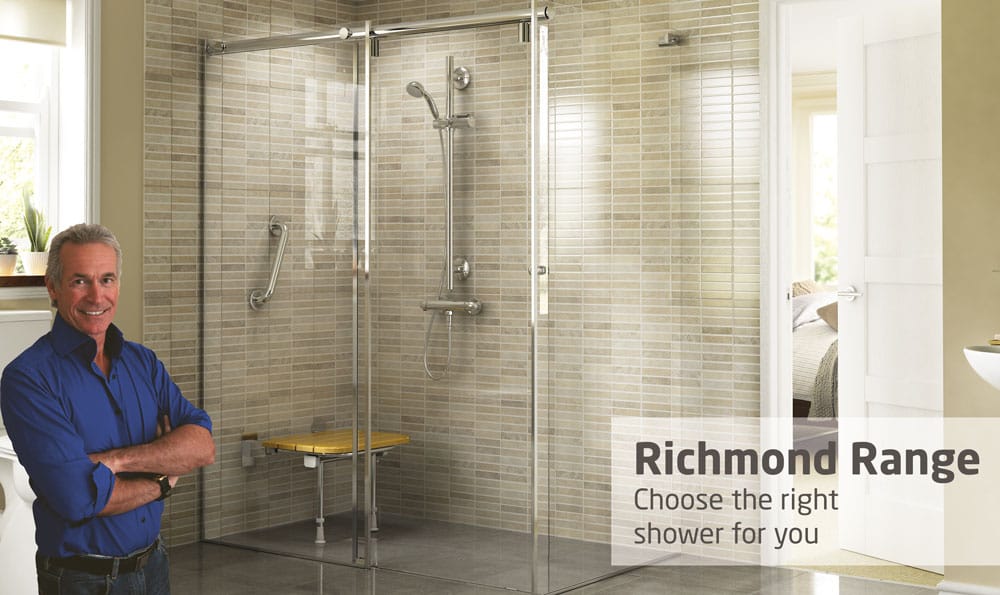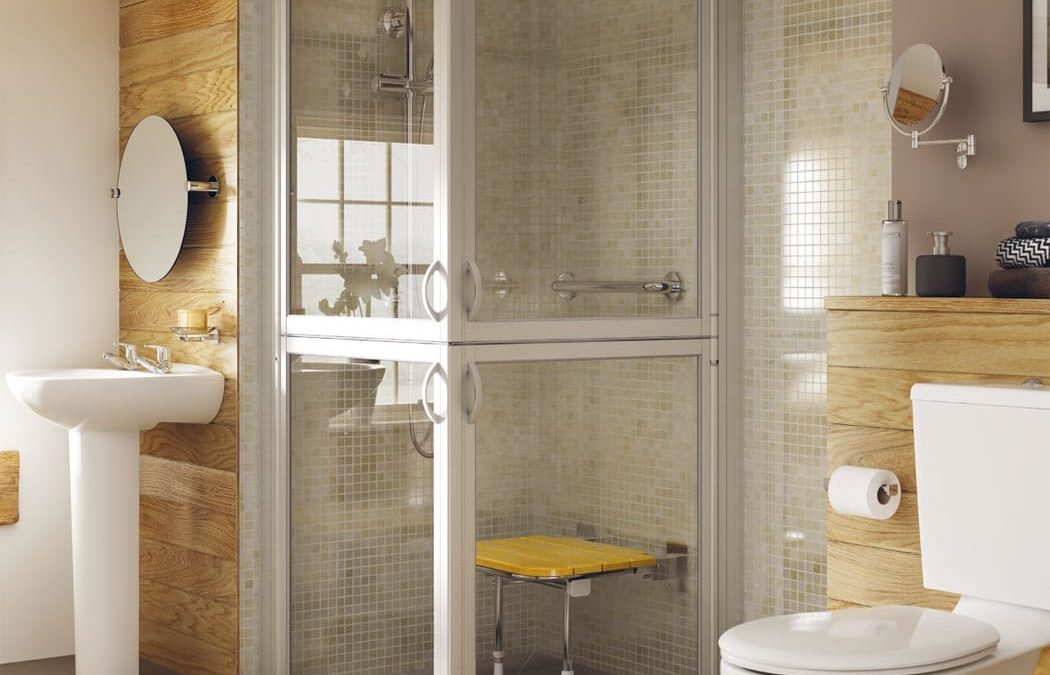
by mobilityplus | 1st Nov, 2022 | Walk-in showers

A shower is something we all enjoy. However, difficulty moving, or fear of slipping or tripping can detract from the pleasure of the experience.
If you’re wondering whether to commit to an entire bathroom redesign or simply want a more comfortable showering experience, here’s a short guide to the difference between wet rooms and walk-in showers.
- What is a wet room?
- What is a walk-in shower?
- What should I look for in a walk-in shower?
- The way to stay independent for longer
What is a wet room?
It does exactly what it says on the tin: it’s a whole room for getting wet in! If you enjoy a shower, but like the freedom of an open room, then a wet room is a great choice. There is no step or lip into the shower, access is level with your flooring.
Request a Free Brochure
Simply fill out a quick form and see how we can transform the way you bathe.
Request Free Brochure
A wet room is usually tiled or has waterproof boards from floor to ceiling, with a central drain within the shower area, it may or may not have an enclosure. The whole room is waterproofed, using underfloor tanking to drain the water with no visible tray on show.
They can also add considerable value to your property, although you’ll need a ‘standard’ bathroom as well to tick all the right boxes. They’re incredibly easy to keep clean, too. At Mobility Plus, we understand the complexities involved in installing a wet room, which is why we ensure our expert plumbers and installation specialists are on hand, so your disability bathroom is completed to the highest standards.
If you’re worried about slipping, we only fit slip-resistant flooring when installing any wetroom.
What is a walk-in shower?
Again, it does exactly what it says: it’s a shower you can walk into without having to step over the side, greatly reducing the risk of tripping or falling.
The simplest walk-in showers are set up as a stand-alone shower pod with a low-access ‘tray’ at the bottom that allows the water to drain away. For those who suffer from serious mobility issues, walk-in showers that have an enclosed area and seating, as well as grab rails or handles, offer a great support solution. If you decide to opt for a walk-in shower, there are plenty of options to choose from.
They can be easily incorporated into your existing bathroom, so you won’t have to sacrifice an entire room for your mobility bathroom. If you only have one bathroom, then a walk-in shower such as the Richmond level access shower or the Coniston showers with bi-fold doors are ideal since they can be tailored to fit your available space and individual needs. Another benefit of walk-in showers is that they can be reasonably compact and fit into relatively small bathrooms, meaning you likely do not have to change the layout of your bathroom space.
What should I look for in a walk-in shower?
Your personal comfort and safety should always be top of the list.
Walk-in showers are specifically designed to offer you a little more security and peace of mind. Because you sit down in many of them, the risk of falling or slipping is almost eliminated entirely. You also have the option to hold onto the sides of the shower to steady yourself as you get in and out. All of this makes showering a more pleasant and relaxing experience.
If your walk-in shower also has a bath facility, such as the Derwent deep soak walk-in bath range, a fast-fill pump system and a thermostat temperature control system can add an extra layer of practicality and luxury to your bathing experience.
The way to stay independent for longer
Washing is such an essential part of our daily lives that having to rely on others to help you can take away a sense of independence. A mobility bathroom can help you maintain your freedom for much longer, with no compromise on personal safety.
A wet room may be the ultimate in bathing luxury for you. Or you may prefer a walk-in shower, which is small enough to be incorporated into almost any existing bathroom layout.
Whichever mobility bathroom model you choose, it’s entirely down to you and your individual needs. Find out more about how Mobility Plus can transform your bathing experience by talking to one of our experts today. If purchasing a bath is a consideration of yours, also consider taking a look at the walk-in baths we offer.

by mobilityplus | 14th Jan, 2021 | Walk-in showers

It’s a debate almost as contentious as whether to put jam or cream on your scone first. Which is better, a shower in the morning or the evening?
Whilst morning shower folk will tell you there’s nothing better than the refreshing blast of a shower first thing, those in the evening shower camp will rave about the blissful sleep they have when they slip into their bedsheets with squeaky clean hair and skin. So, who is right?
Lucky for you, in this article we lay the case for both sides to help you decide once and for all.
The Morning Shower
Pro: After a night of sleeping, a morning shower allows you to wash off any bacteria or sweat you may have accumulated whilst you were dreaming away. Particularly if you suffer from an oily complexion, which is likely to be all over your body and not just your face; a dip in the shower can quickly leave your skin feeling balanced and fresh.
Con: With similar thinking in mind, it is likely you will pick up more dirt and sweat throughout the daytime. Therefore, by sticking with your morning shower, you run the risk of heading to bed feeling grubbier with a build-up of bacteria on your body.
Pro: If you struggle with rousing after your alarm rings, a morning shower can be the perfect wake up call. Many people are now even turning to a quick blast from a cold shower before they commence their usual cleaning ritual to help them feel refreshed and ready for the day.
Want to improve your showering experience?
Simply fill out a quick form and see how we can transform the way you bathe.
Request Free Brochure
Science also backs this cold shower trend, with researchers showing benefits from reducing low mood and stress levels to a more robust immune response. A brief morning shower with a 15 to 30-second cold plunge has been shown to help with awakening and stimulating blood circulation.
Con: If you’re wrestling with poor sleep, then that may be the first thing you should address rather than working on waking yourself up! Poor sleep ensures you wake up feeling groggy, therefore by improving your nightly z’s using the warm shower technique before bed, you could feel more alert earlier in the day.
Pro: Morning showers encourage productivity. Studies show that a cool stimulating shower in the morning boosts productivity for the rest of the day. This is due to the time it gives you whilst under the spray of water. This time can be used to regroup and meditate before the day to come. Studies show that taking a shower can have a similar effect to meditation when it comes to brain waves, allowing your brain to enter the alpha state; known to be the perfect condition for big ideas and creativity.
Con: Your schedule may not allow for time in the shower. If you find yourself rushing from bed, to shower, to the car in the morning, then it may be better for your productivity to plan your shower for the night before. The benefits of meditation and inspiration will be totally lost if you are rushing to fit in a good wash!
Pro: A smooth shave and glowing skin. If you shave, then the morning shower is the best option here. Not only are you more alert in the morning, so less likely to cut yourself, but morning is the time when you have a surge of platelets (which help your blood to clot). What’s more, a hot, steamy shower will help to open pores and soften hairs, making for a more comfortable shave. Your skin will also appear more refreshed after a morning shower. Our skin cells relax overnight and are then stimulated by the water, prior to encountering any dirt, debris and free radicals from the outside world. This is particularly significant for acne-prone or oily skin.
Con: Be warned though, the temperature is important here. Although the morning shower may help your skin appear healthier, if you turn the heat up too far it will have the opposite effect. More so if you already suffer from dry or sensitive skin.
The Evening Shower
Pro: A morning shower may make your skin look refreshed, but dermatologists agree that an evening shower is better for your skin because it cleanses it before you sleep. This removes pollutants, which if accumulated, will produce free radical damage and cause inflammation. It also feels great to have metaphorically ‘washed off’ the day and the dirt before you get into bed. Furthermore, most people have more time for a longer bedtime routine in the evening meaning they can use this to apply lotions and creams to keep skin soft and moisturised.
Con: You could wake up feeling a little oily. When you sleep, your skin produces sebum and sweat, so those who suffer from already oily skin may wake up feeling extra greasy. Cleansing can help remove some of the excess oil or you may want to wash your whole body, especially your back where hair products can be left unrinsed.
Pro: A good night’s sleep. Sleep Ambassador, Nancy Rothstein is Team Evening Shower when it comes to getting your full forty winks. Not only is it important to go to bed clean, it also allows you to prepare for bed with a perfect routine to aid sleep. It gives you time to yourself, no phones, screens or distractions – just you and the warming, clean water. Rothstein calls it an opportunity to shower yourself with mindfulness.
Scientists also agree that showers in the evening can help you sleep better. As you shower in the warmth, your core temperature actually drops. Although your skin may feel hot, you’ll notice you feel colder after towelling off and putting on your pyjamas due to moisture evaporating off your skin. By cooling the body in this way, you enable the onset of sleep to come round faster, research has shown.
Con: Going to bed with wet hair on the other hand not only may disrupt your sleep but can also damage your hair follicles. Water from your hair and a wet pillow makes the perfect environment for yeast to grow which can cause dandruff. It also traps moisture in the different layers of your hair, causing hair cuticles to rupture leaving you with a weathered effect.
Pro: If you are prone to allergies, evening showers can help. Coming inside from the outdoors often means bringing in pollen and chemicals which contaminates your bedding if you go without a full body wash. This is often worse when seasonal allergies are at their peak, but at other times of the year, creams, make-up and hair products can attract more pollen to your body and cause further reactions.
Con: Your schedule will dictate the best time to shower in the case of sensitives. If you prefer to exercise in the morning, for example, it is much more beneficial to follow up with a shower to cleanse the skin and hair and wash off excess sweat and bacteria from any equipment.
Or you could even consider being in the two-showers a day tribe!
Can you do both?
Can’t decide? Well, some people swear from having a shower both in the morning and at night, especially in the summer or if they live in a warmer climate. Keeping these showers quick will ensure your skin doesn’t dry out.
Depending on your working environment this could be the perfect solution. For those who work in schools or public places, they may want to keep on top of how many germs they are gathering throughout the day. Even those who live in busy cities should consider an extra shower here and there. However, the downfall of this is of course the impact on the planet. If water wastage is a particular concern of yours, then you may want to take a look at products available which help you to time your shower and capture the water.
So, which camp do you fall into now? If you still can’t decide, perhaps it’s time to run a bath!

by nadezda gurska | 12th Sep, 2017 | Walk-in showers

As we get older, our health can decline which can cause a wide range of mobility issues. Daily routines can become challenging, so we have to consider our safety as well as our independence. Millions of people all over the world take cleanliness and hygiene for granted, but as one of the most accident-prone rooms in any home, the bathroom is a place where safety is paramount.
For those of us who develop back or leg problems in our older age, or require a wheelchair, standing in a shower not only becomes an incredibly risky prospect due to slippages, but it can be impossible for some to enter in the first place. Luckily, we now have anti-slip bathrooms and walk-in showers, helping us to maintain our independence and safety.
Request a Free Brochure
Simply fill out a quick form and see how we can transform the way you bathe.
Request Free Brochure
The great thing about walk in showers is that they are built to suit your personal needs. Easy-access trays reduce the risk of slipping, and level-access trays allow for the movement of wheels, making it a suitable choice for wheelchair users. Alternatively, wet rooms give you more flexibility and are also an excellent option for wheelchair users…
Another key element of the walk in shower is the choice of door. Full height doors/panels can provide adequate entry width for wheelchair users, and half height doors provide flexibility and ease of access, and can be an excellent choice if you have a carer or you think you may need carer support in later years.
And last but not least, extra features such as hinged safety seats and safety grab rails can make showering possible for those who struggle to stand up or maintain balance, making it entirely possible for people with mobility issues to not only maintain their independence at home, but also maintain their safety.
One of the reasons I recommend Mobility Plus walk-in showers in particular is because their showers are manufactured to the highest standards, come in a variety of sizes and models to choose from, and they all come complete with an extensive product guarantee for your peace-of-mind.
Our Richmond Range is our beautifully stylish walk-in shower range, which features clear toughen glass and high quality polished aluminium finish. Adding a touch of class to any bathroom, they’re designed to create a relaxing refuge of calm, for a truly luxurious showering experience.
Combining perfect form with discrete functionality and practical features designed for those with limited mobility, the Richmond Range has been developed with safety, flexibility and ease of use in mind. Our Richmond walk-in shower enclosures and wet rooms give you independence, comfort and style all-in-one.
Choose the right shower for you.
Request your FREE brochure or quote for The Richmond Range.
Take a look at our other walk-in showers, or if you’re preferred bathing option is a bath, see our walk-in bath range.

by nadezda gurska | 6th Sep, 2017 | Walk-in showers
As we’ve said many times in our blog section, personal care for someone with mobility restrictions can be a troublesome task, therefore adapting your bathroom to assist your daily routine can be a helpful investment. If you think that you need some mobility aids in the bathroom, but you’re not sure whether a Mobility Plus bathroom is right for you, we’ve outlined some straight to the point details on the features that Mobility Plus can offer for elderly or disabled walk-in showers to help you make your decision. If you are more interested in an accessible bath, take a look at our range of walk-in baths.
Low level entry
Mobility Plus can offer level wet room flooring or low level shower trays, allowing you to walk straight in and out of the shower without lifting a limb. Depending on the door frame you choose, the level wet room floor allows for wheelchair access giving you even greater independence. All floor options come non slip to give you extra peace of mind when moving around the shower.
Fold down shower seats
Standing for a while in the shower isn’t always an option, therefore having a neat, tidy yet practical fold away chair can be a huge comfort. The seats that Mobility Plus incorporate into your walk-in shower flips up when not in use to allow wheelchair access and safe environment when standing, but is easily available if needed.
Request a Free Brochure
Simply fill out a quick form and see how we can transform the way you bathe.
Request Free Brochure
Hand grab rails
Hand grab rails are the most basic mobility aids feature for any bathroom installation specialists. They are simple to install in any place and in multiple locations if required. Great for giving you that extra boost for hoisting you in and out of a wheelchair or up and down of your shower seat. Or just to steady you whilst standing.
Wide entry doors
We install a range of door types and sizes but the wider opening or rimless framed doors are often suited to those with disabilities because you have more room to manoeuvre and wheelchair access.
Bifold doors
The bi fold door option is helpful for those needing assistance from another person. The doors can be opened half way to allow a carer to lean over and assist without getting wet themselves.






